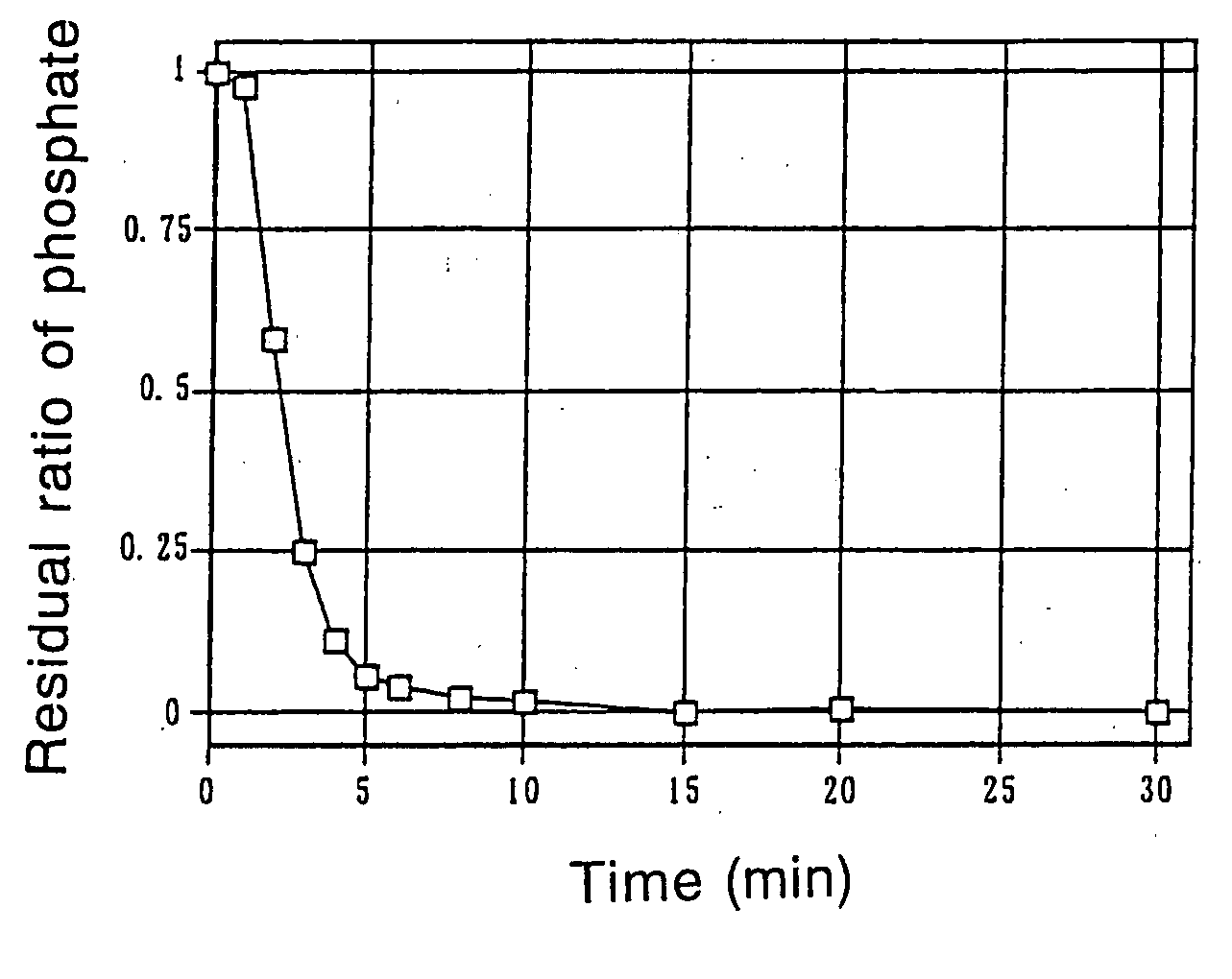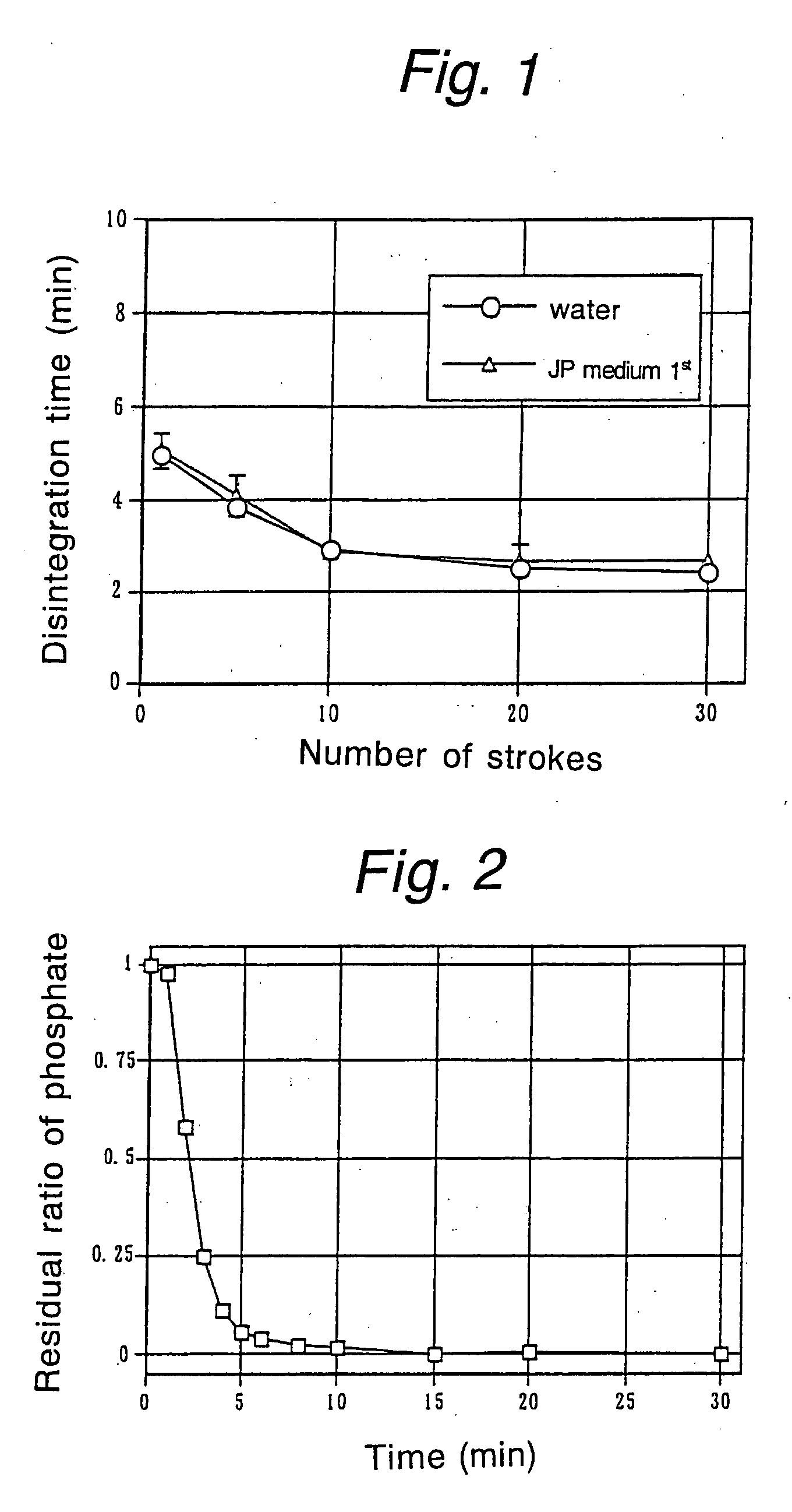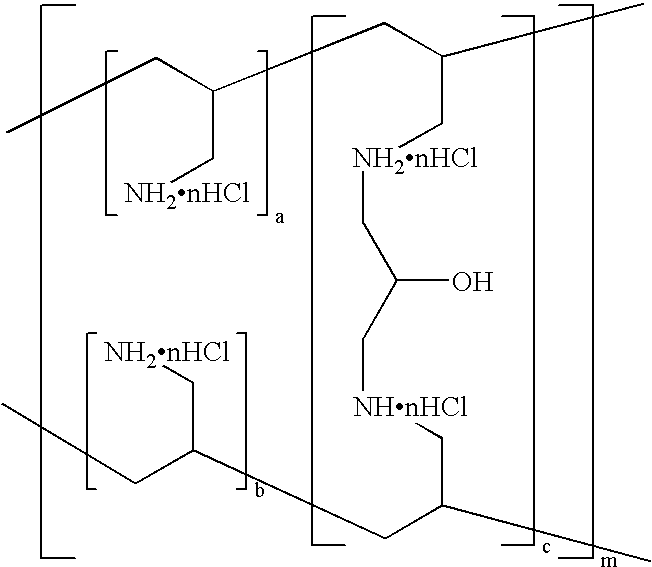Phosphate-binding polymer and tablets using the same
a phosphate-binding polymer and tablet technology, applied in the field of phosphate-binding polymers and tablets, can solve the problems of no specific example of tablet formulation and no tablet could be produced successfully, and achieve the effect of high phosphate-binding capability and rapid disintegrability and dispersibility
- Summary
- Abstract
- Description
- Claims
- Application Information
AI Technical Summary
Benefits of technology
Problems solved by technology
Method used
Image
Examples
example 1
[0031] The particles of the water-containing phosphate-binding polymers obtained in Preparation 1 (to give true specific gravities of 1.209-1.211) and those of the polymer obtained in Preparation 2 (to give a true specific gravity of 1.253) were compressed under various static pressures of 500-1750 kg into tablets of 10 mmφ each weighing 300 mg. These tablets were measured for hardness with a hardness meter (Pharmatest). The results are shown in Table 1.
TABLE 1Preparation 1Preparation 2True specific gravity1.2091.2111.2111.2531.253Water content2.5%2.1%2.1%3.6%3.8%Under 300 μm size99.0%99.6%99.3%99.7%99.3%Compressingpressure: 500 kg 2.1 KP 4.7 KP 2.0 KP0.5 KP0.8 KP 750 kg 5.1 KP 9.2 KP 4.0 KP0.8 KP1.5 KP1000 kg10.8 KP11.6 KP 8.5 KP1.3 KP2.5 KP1250 kg13.1 KP19.0 KP11.2 KP2.2 KP3.5 KP1500 kg19.5 KP20.0 KP13.8 KP2.6 KP4.6 KP1750 kg23.9 KP24.3 KP15.5 KP3.6 KP5.6 KP
[0032] As one can see from Table 1, none of the tablets compressed solely from the phosphate-binding polymer with a true sp...
example 2
[0033] Two hundred milligrams of the particles of the water-containing phosphate-binding polymer with a true specific gravity of 1.209 which was obtained in Preparation 1 were mixed with 100 mg of an additive crystalline cellulose (Avicel™ PH101 of Asahi Chemical Industry Co., Ltd.) and the blend was compressed under static pressures of 500 kg, 750 kg and 1000 kg into tablets of 10 mmφ each weighing 300 mg.
[0034] These tablets were measured for hardness with a hardness meter. The tablets compressed at a pressure of 750 kg were also tested with a disintegration tester (Toyama sangyo) using water as a test fluid. The results of both tests are shown in Table 2.
TABLE 2CompressingDisintegrationpressure:Tablet hardnesstime500 kg5.7 KP20 seconds750 kg9.0 KP1000 kg 13.6 KP
[0035] As one can see from Table 2, the tablets compressed from the blend of the phosphate-binding polymer and crystalline cellulose at pressures of 750 kg and more had hardness values of at least 6 KP and exhibited ra...
example 3
[0036] To 767.7 g of the particles of the water-containing phosphate-binding polymer with a true specific gravity of 1.209 that was obtained in Preparation 1, 349.5 g of crystalline cellulose, 5.6 g of a hardened oil (Lubriwax™ 101 of Freund) and 2.2 g of a lubricant magnesium stearate (Nitto Kasei) were added and the ingredients were mixed together. The resulting blend was set on a single-action tableting machine (Model N-30 of Okada Seiko) and compressed at 1750 kg into tablets of 10.5 mmφ each weighing 375 mg. This yielded uncoated tablets each containing about 250 mg of the dry phosphate-binding polymer.
[0037] These tablets were measured for hardness with a hardness meter (Contester), which read a value of 10.9 KP. They showed a disintegration time of 67 seconds (test fluid, water).
[0038] The tablets each containing 250 mg of the phosphate-binding polymer were coated with a film comprising 8.25 mg of hydroxypropyl methylcellulose 2910 (HPMC TC-5-RW of Shin-Etsu Chemical Co., L...
PUM
| Property | Measurement | Unit |
|---|---|---|
| particle size | aaaaa | aaaaa |
| particle size | aaaaa | aaaaa |
| particle size | aaaaa | aaaaa |
Abstract
Description
Claims
Application Information
 Login to View More
Login to View More - R&D
- Intellectual Property
- Life Sciences
- Materials
- Tech Scout
- Unparalleled Data Quality
- Higher Quality Content
- 60% Fewer Hallucinations
Browse by: Latest US Patents, China's latest patents, Technical Efficacy Thesaurus, Application Domain, Technology Topic, Popular Technical Reports.
© 2025 PatSnap. All rights reserved.Legal|Privacy policy|Modern Slavery Act Transparency Statement|Sitemap|About US| Contact US: help@patsnap.com



